Nokia Lumia 830 Review
by Brett Howse on November 25, 2014 8:00 AM EST- Posted in
- Smartphones
- Microsoft
- Lumia
Camera
The Lumia 830 carries the PureView branding on the camera, which Nokia has saved for the heavy hitting cameras. As the line has evolved, the PureView brand appears to be for phones with Optical Image Stabilization (OIS), although as with any branding that may change in the future. The Lumia 830 is by far the lowest end PureView camera so far, with just a 1/3.4” sensor size attached to the OIS mechanism and the six lens optics. The 10.0 megapixel count results in the typical for Lumia 1.1 µm pixel size. The sensor is also a 16x9 native format. The flash is handled by a single LED. It is good to see OIS in a midrange device such as this but the small sensor and small pixel size is going to limit the amount of data that can be collected in dim lighting even with OIS allowing the exposure time to be a bit longer than normal.
To measure camera performance we start with the ISO12233 chart which allows us to test for spatial resolution as well as the amount of processing done by the ISP to get rid of aliasing.
ISO12233 Test Chart
With a smaller sensor size and the same small pixel size, the Lumia 830 cannot do the pixel binning of its PureView brethren. The ISO chart reveals that this is not the same PureView as other devices with the same branding.

Once we dig into the chart a bit, we can see that the Lumia 830 starts to struggle around the 13 mark on our chart. This is not all about pixel count either, as the lower resolution iPhone can capture up until the 15 mark. The Lumia 930, with its much larger 1/2.5” sensor can pretty much resolve the entire chart and the Lumia 1020 with the PureView 41 MP camera easily resolves the sagittal lines.
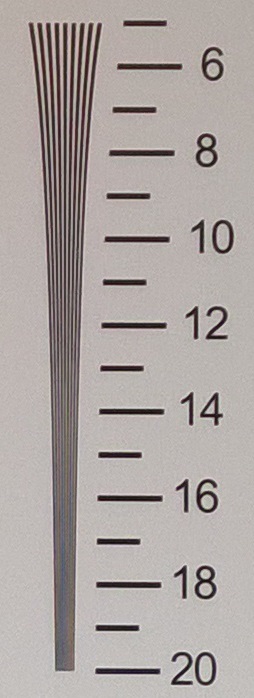
The tangential lines show a similar story, with the Lumia 830 unable to resolve after around the 13 mark. With a 10 MP sensor, I would have hoped to see it resolve at least the same as the iPhone.
Next we will take a look at some controlled scenes.
Controlled Scenes
The Lumia 830 does a good job on a well-lit scenes. The amount of detail is good, and the color balance is very good as well. These shots were taken in full auto, so while it would be possible to correct the Lumia 1020 white balance with the manual controls, most of the time people just leave the camera in auto so it is important for the device to get the right cast.
To stress the camera under poor lighting, we set the light box to 5 lux and leave the flash off. The Lumia 830 does a decent job here again, once again getting the white balance spot on. As compared to the Lumia 1020 photo, there is quite a bit more noise in the final image which is not surprising with the sensor size difference. If you were not going to crop this image it would be very usable.
Outdoor Scenes (Night)
Moving out of the comforts of home, I braved the elements to get some outdoor pictures. The first scene is a park bench which is lit by a low-pressure sodium-vapor light which has a distinctive yellow hue. This scene is dark enough that the image preview on the phone is pretty hard to make out.
The Lumia 830 does a good job with this scene. It keeps some of the yellow cast of the sodium light, but the result is a very usable photo. If you zoom in on it, there is more noise than the 1020 but the overall result is very good.
The picture of the grocery store tells a similar tale. The Lumia 830 gets a better white balance than the Lumia 1020 and the result is a good photo. The Lumia 1020 as always struggles to get the correct white balance when in auto mode even though the resultant picture has much less noise.
Outdoor Scenes (Day)
Moving to daytime, there is generally ample light that even small sensors have no issue getting a reasonable photo.
The Lumia 830 had no issues during daylight with any of the subjects. This picture makes a great comparison with the detail loss as compared to the Lumia 1020. Please ignore the color differences between the photos as the sun ducked behind a cloud, but instead look at the detail of a zoomed in image.
 Lumia 830 (Left) vs Lumia 1020 (right) in Cropped comparison - view at full resolution to see full effect
Lumia 830 (Left) vs Lumia 1020 (right) in Cropped comparison - view at full resolution to see full effect
The Lumia 830 is a good camera for basic point and shoot smartphone photography but it lacks the imaging power of the other PureView phones such as the 930 and 1020. A 1/3.4” sensor and the much lower pixel count removes the ability to do pixel binning to improve the overall result, and it also removes the ability to do lossless zoom.
Another missing feature from the Lumia 830 as compared to the other PureView cameras is the ability to capture in RAW format.
As a still photograph camera, we still need to look at one more feature that can impact camera use – latency.
Capture Latency
Being able to take a photograph quickly can mean the difference between getting a great shot and missing the subject altogether. We have seen a great push in the industry in the last while to improve the focus latency, with some cameras now using phase detection and other tricks to increase the focus speed. The other half of that is the capture latency of taking the photo and saving it so that the camera app is ready to go again. We will start with focus. As with the performance benchmarks, I sampled several phones that may be shopped against the Lumia 830. If you want to check out the 830 against any other device, please visit our benchmark comparison pages in Bench.
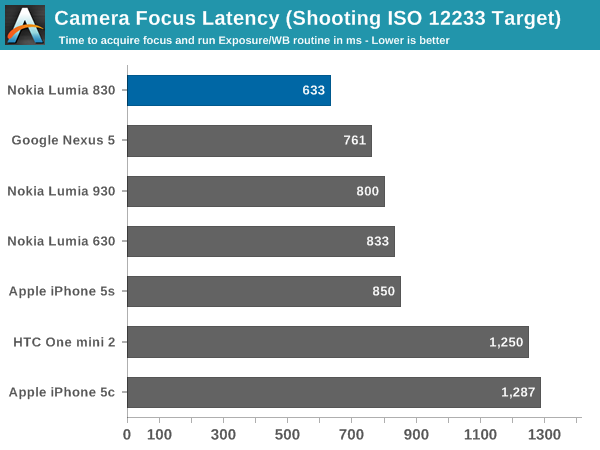
The Lumia 830 is the fastest Lumia I have tested for focus latency, with it occurring in just over 600 ms. While not the outright fastest device for focus we have ever tested, improvement is always welcome. Next up, we will look at the latency to initiate a photo save it to disk.
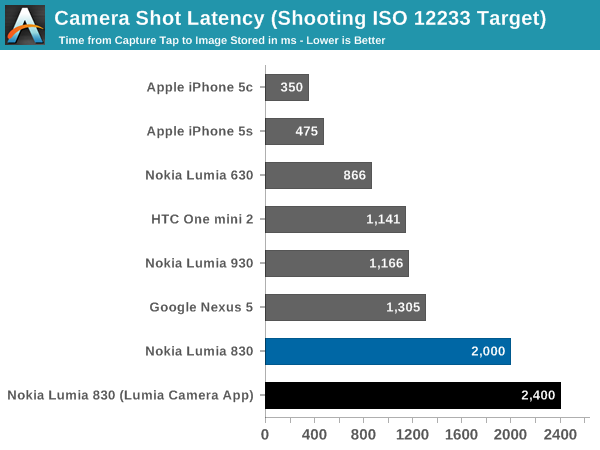
At IFA, Microsoft announced they were going to be launching a new camera app at the end of this year and it cannot come soon enough. The Lumia Camera app is especially slow, with a total capture latency of 2.4 seconds before it is ready for another shot. The default Windows Phone camera app is slightly faster at 2 seconds even. The Lumia 930 outperforms it here which likely means that it is being held back by the slower SoC onboard.
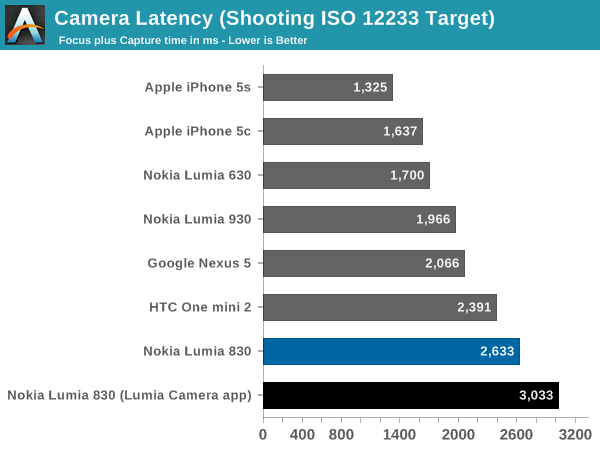
Total latency is the time to focus and the time to capture and save the image. The Lumia 830 is a very slow camera. It is hard to say anymore other than hopefully the new camera app improves this situation.
Video
The 830 has four microphones which allow it to capture video in Dolby Digital surround sound, which is a nice bonus. The video resolution and frame rate options are fairly sparse though, with the only options being 1080p or 720p at 24, 25, or 30 frames per second.
I did two videos with the first one being during the day and the second one at night.
The video during the day was during very high winds (50 km/h+) and with the default low pass filter enabled on the video the amount of wind noise was pretty good.
The night video shows the limits of the sensor quite clearly. OIS helps with the camera shake, but on still photography it allows for an increased exposure time to combat a small sensor. On a video, the sensor gets no such bonus and as such there is quite a bit of noise.


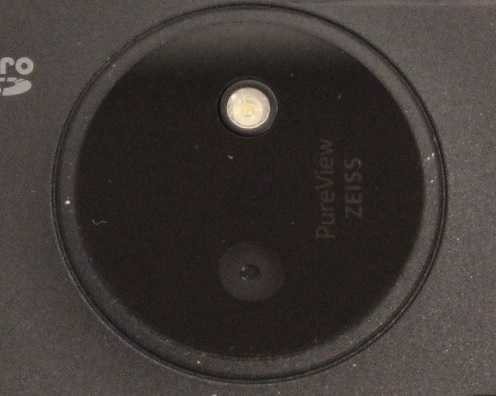
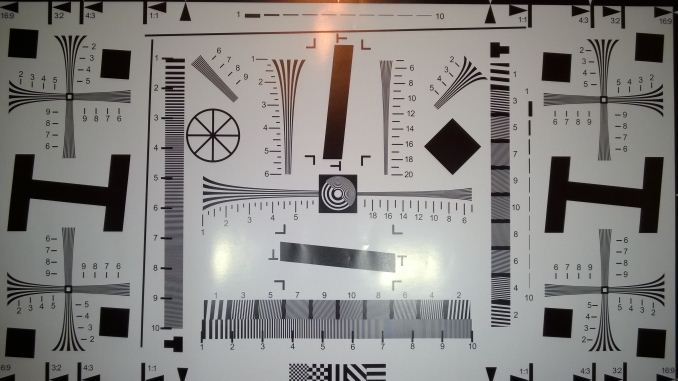


















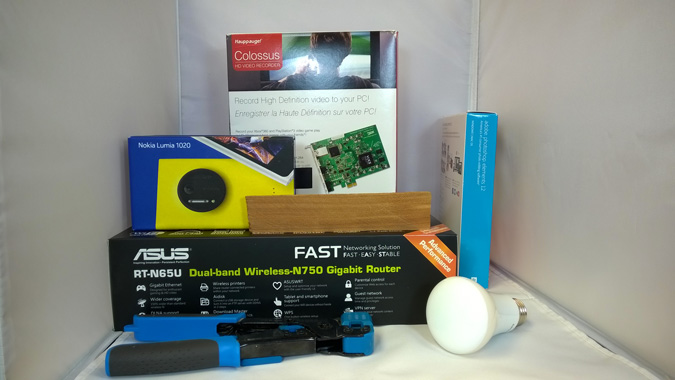


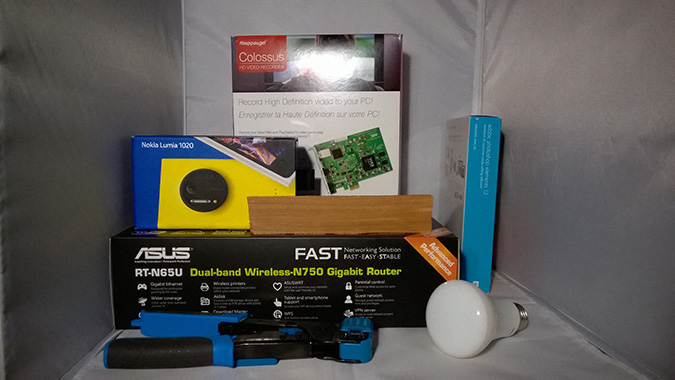





















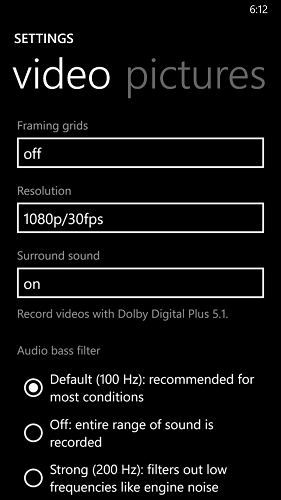








98 Comments
View All Comments
kspirit - Tuesday, November 25, 2014 - link
I was hoping to get this as an upgrade to my 925, but it offers nothing excellent. The camera and display are underwhelming. This is still an incredibly good-looking phone though, but nothing exceptional besides that. The cutbacks Microsoft is making on Lumias are pretty obvious... They're kind of ruining the solid hardware reputation of Nokia.BMNify - Tuesday, November 25, 2014 - link
what cutbacks? Why were you hoping to upgrade from 925 to an 830?? you should be looking at 930 or 1520 for proper upgrade not downgrade to 8xx series and then complain about cutbacks.retrospooty - Tuesday, November 25, 2014 - link
LOL... It's like saying the 2014 Civic isn't as feature rich as the 2013 Accord. Of course not.PubFiction - Tuesday, November 25, 2014 - link
He has a pretty good point, if this phone wants to be a premium phone alternative it needs to have at least something of the major components that would actually be considered premium. It has nothing. Premium phones are 1920x1080 or better, they have 2GB of ram or more, they have snapdragon 800+ chipsets. This phone doesn't have any of that so the reality is it just isn't a premium phone its an average midrange phone.kspirit - Wednesday, November 26, 2014 - link
THIS! Thank you.cheshirster - Friday, November 28, 2014 - link
Average midrange phones do not have what Lumia 830 has.OIS and Qi are not widely presented
Not every flagman has HAAC mics
Metal body is nowhere to be seen under 400$ mark.
Laxaa - Sunday, November 30, 2014 - link
Those are very valid points. HAAC mics are a great feature I wish every phone had. I mean, most of the high-end flagships today(iPhone 6 and Nexus 6 in particular) only captures mono sound. It's kind of funny when companies boast their 4K recording capabilities without any decent sound recording to back it up. Not even stereo(Samsung, Sony and HTC does stereo so it's not all lost)garretelder - Thursday, December 4, 2014 - link
Not one of the top phones (see http://www.topreport.org/phones/ instead) in my opinion.retrospooty - Monday, December 1, 2014 - link
I am not seeing it... It is not a high end model. It's a low end model. Why would the 830 be "premium", it's a low end phone? What he should be looking for is the (assumed) upcoming model replacement for the 925, which is a higher end model - not the 830.Let me put it another way since the car thing didn't seem to work... It's like saying the 2014 Moto G isnt as nice as the 2013 Moto X. - different model families... Get it?
kspirit - Wednesday, November 26, 2014 - link
I thought it was clear...?They eliminated Glance on almost all the current lineup to save on display cost.
They also removed the camera buttons on all phones below the 830.
In a day where cheaper phones have 1080p displays, they still offer a badly calibrated 720p panel, and a camera with a sensor size that is almost an insult to the name of PureView. This doesn't even touch the upper range, despite being marketed as an 'affordable flagship'...